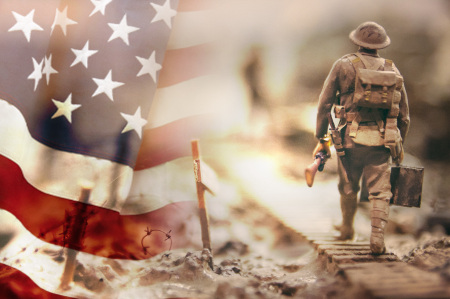Through most of the 20th century, the U.S. armed forces applied asbestos-containing products to benefit fully from the material’s unique properties. With the Navy, Marines, Army, Air Force, and Coast Guard utilizing contaminated products, many veterans were exposed to asbestos while defending our country. Today’s growing number of toxic exposure cases among these brave men and women underlines the health risks they have taken, barring the challenges of service. As veterans embrace civilian life after service, they now face developing life-altering asbestos diseases stemming from their military years.
Asbestos contaminating military installations all over the state
The fibrous material was celebrated for its insulating and fireproof properties in the past, and nobody thought about asbestos being a threat when its microscopic fibers were released into the air and inhaled. It is why asbestos exposure is still a matter for all veterans who might have the toxic fibers in their lungs, including those of the veteran community in Maryland. Even though the military used asbestos for insulation in aircraft, military vehicles, barracks, ships, shipyards, and various tools in the first place, the Navy exploited it the most. Therefore, veterans serving onboard naval vessels during the last century were at a remarkably high risk of asbestos exposure.
Maryland is home to eleven military bases for every branch, except for the USMC, though Marines train at the U.S. Naval Academy. These installations are primarily Army and Navy bases, but the Air Force also has a presence in the state. The Coast Guard Yard in Baltimore is one of the most unique military facilities, acting as a shipyard. The assembly of Maryland military installations and military support centers is pivotal for the evolution of the American Armed Forces through superior training, high standards, and innovation. During WWII, Maryland’s airfields were training grounds for pilots and aircrews of USAAF fighters and bombers. Moreover, the? Maryland National Guard played an essential role in the war, as its units took part in the D-Day landings in 1944 and participated in battles across France, Holland, and Germany.
Veterans’ slowly deteriorating health after asbestos exposure
During their military service, veterans often lived and worked with asbestos-containing materials nearby, unaware of the danger they represented. The toxic material was abundant on military property like engine rooms, aircraft, sleeping barracks, and mess halls. It has put service members at a constant and elevated risk of asbestos exposure.
Because the structure and size of asbestos fibers enable them to float in the air for hours, most military bases were asbestos-exposure sources back then. Thanks to their microscopic size, asbestos threads are easily inhaled or ingested, and once inside the body, they cause irreversible damage to major organs and lead to devastating illnesses.
Asbestos-related diseases cause havoc only after a decades-long latency period between exposure and the first symptoms. Even if veterans may not have experienced health issues during their service, they’ll discover the impacts of asbestos exposure only years later when they are diagnosed with illnesses related to it, like mesothelioma, lung cancer, asbestosis, or other respiratory conditions.
The ongoing struggle for well-being
Although many years have passed since the armed services used asbestos, veterans who came in contact with it during their military duty now have to struggle for their health. Many must handle the jarring reality that their service to the country implies an enormous personal sacrifice and that other than affecting them physically and psychologically, their asbestos diseases shorten their lifespan and steal valuable time from their families.
With Maryland ranking 15th among all states for lung cancer and 14th in the country for deaths related to asbestos exposure, veterans should not delay making an appointment with the doctor. Given that early detection can considerably improve treatment results and can add years to life, they must take proactive steps to secure their health through:
- Regular check-ups: Planning medical examinations periodically and discussing military duty and possible asbestos exposure is crucial. The inhaled asbestos fibers damage the lungs first, so veterans should request chest X-rays or CT scans and pulmonary function tests (also known asthe breathing test). These imagistic tests reveal any changes caused by the toxic fibers and are a diagnostic tool for benign and malignant asbestos-related illnesses.
- Legal rights: Veterans who know they’ve worked with asbestos during their service, or those who reckon they’ve been exposed to asbestos, should know their rights and options. Compensation programs and legal avenues are available to assist those affected by asbestos exposure.
As a veteran, you have the legal right to seek indemnification from asbestos trust funds and apply for VA disability benefits. Asbestos trust funds are a notable source of monetary compensation for people harmed by occupational exposure, including former armed forces personnel. These funds were set up by liable companies that entered bankruptcy protection and have approximately $37 billion currently available for future claimants. Veterans harmed by asbestos exposure during service can file compensation claims with both asbestos trust funds and Veterans Affairs.
- Raise awareness: Protecting the other is among the valuable lessons in the military. Vets can play an essential role in raising awareness and educating their community by sharing their knowledge about the risks of asbestos exposure with fellow vets. In doing this, they can help make sure that others who protected our nation are informed.
As we express our gratitude to veterans, we also acknowledge our responsibility to protect their health and well-being. Awareness of asbestos exposure is an important part of this responsibility. By shedding light on this still lurking danger, we can ensure that those who served receive the care and support they rightly deserve.








Recent Comments